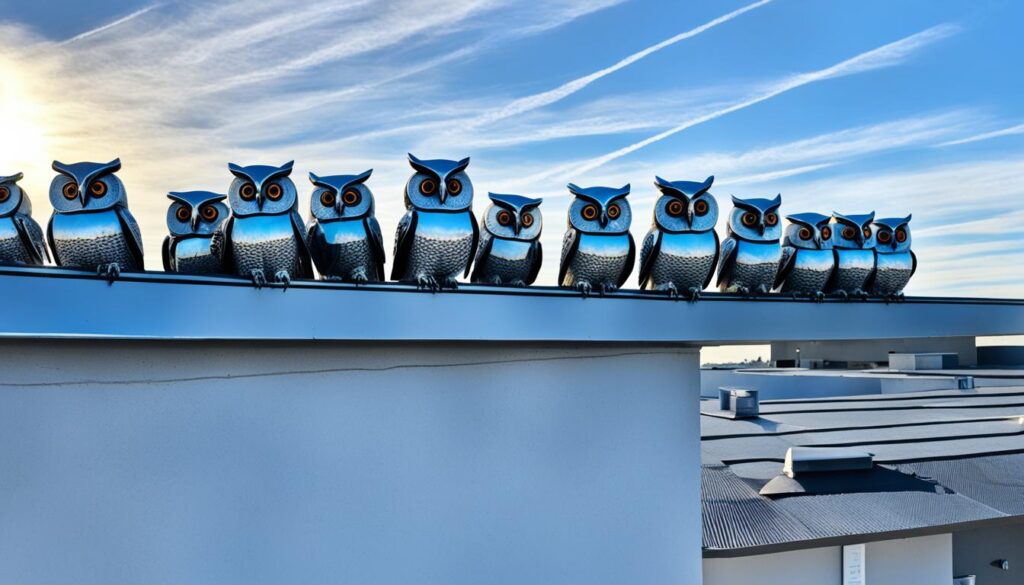Did you know that the presence of birds on your roof can lead to serious damage to your home? According to a recent study, the acidic droppings from just a few birds can potentially shorten the lifespan of asphalt roofing materials by years. And that’s not the only threat – birds nesting in gutters or near HVAC equipment can also pose fire hazards and increase the risk of water damage. With the potential for health risks and costly repairs, it’s essential to take action to scare birds away from your roof.
In this comprehensive guide, we’ll explore a range of effective methods to deter birds and prevent them from nesting on your roof. From using predator decoys and sonic deterrents to installing specialized bird spikes and netting, you’ll learn how to reclaim your roof and protect your home from the nuisance and dangers of unwanted avian visitors.
Key Takeaways
- Acidic bird droppings can damage and shorten the lifespan of asphalt roofing materials
- Birds nesting in gutters or near HVAC equipment pose fire and water damage risks
- Birds can carry diseases that create health and sanitation issues for building occupants
- A variety of effective, humane deterrents are available to scare birds away from roofs
- Maintaining roof integrity and eliminating food/water sources are key to preventing bird infestations
Why Birds on the Roof are a Nuisance
Birds nesting on your roof can pose serious health risks and potential damage to your home. One of the primary concerns is the health hazards associated with bird droppings. Bird feces contain over 60 zoonotic diseases that can be transmitted to humans, especially when the droppings dry out and become airborne. Exposure to infected matter can cause illnesses like Cryptococcosis, Psittacosis, and Histoplasmosis.
Health Risks from Bird Droppings and Nests
Birds can also bring parasites like bed bugs, ticks, and lice into the home. Their nests and droppings can also attract other pests such as rodents and snakes, further increasing the risk of disease and damage. Ingesting or inhaling dried bird droppings can lead to severe respiratory problems, including lung infections and allergic reactions.
Potential Damage to Roofing Materials and Home
In addition to the health risks, the acidic nature of bird droppings can also cause significant damage to roofing materials, gutters, solar panels, and air conditioning units over time. The buildup of nesting materials and droppings can clog gutters, leading to water damage and leaks. Bird nests in chimneys can also pose a fire hazard and prevent proper ventilation, potentially leading to carbon monoxide poisoning.
To maintain the integrity of your home and ensure the safety of your family, it’s crucial to address any bird infestations on your roof promptly. By understanding the potential risks and taking proactive measures, you can effectively scare birds away from your roof and prevent further issues.
“Birds can be helpful in some ways, feeding on predator insects and seeds of pesky weeds, but can also cause damage and health risks by feeding on fruits and veggies and leaving droppings.”
Common Attractions Drawing Birds to Your Roof
Birds are often drawn to rooftops due to a combination of factors that make these elevated structures appealing nesting sites. From readily available food and water sources to the lack of natural predators, the roof of your home can become a prime real estate for feathered tenants.
Food and Water Sources
One of the primary reasons birds are attracted to roofs is the easy access to food and water. Improperly stored or discarded trash, pet food left outdoors, and standing water in gutters or on flat roofs can all serve as tempting sources of sustenance for birds looking to establish a home. These convenient food and water supplies make rooftops an attractive option for birds seeking to support their young.
Nesting Sites
As urban development continues to expand, birds must adapt and find suitable nesting locations. The height, shelter, and relative seclusion offered by roofs can make them an ideal choice for birds to build their homes. Ledges, vents, chimneys, and other structural features on the roof provide the perfect materials and protection that birds require for their nests.
Lack of Predators
Compared to natural environments, rooftops often have fewer natural predators that would threaten a bird’s nest or hatchlings. The physical separation from ground-dwelling predators, such as cats and raccoons, can make rooftops a safer haven for birds to raise their young. This reduced risk of predation is a significant factor that draws birds to nest on roofs.
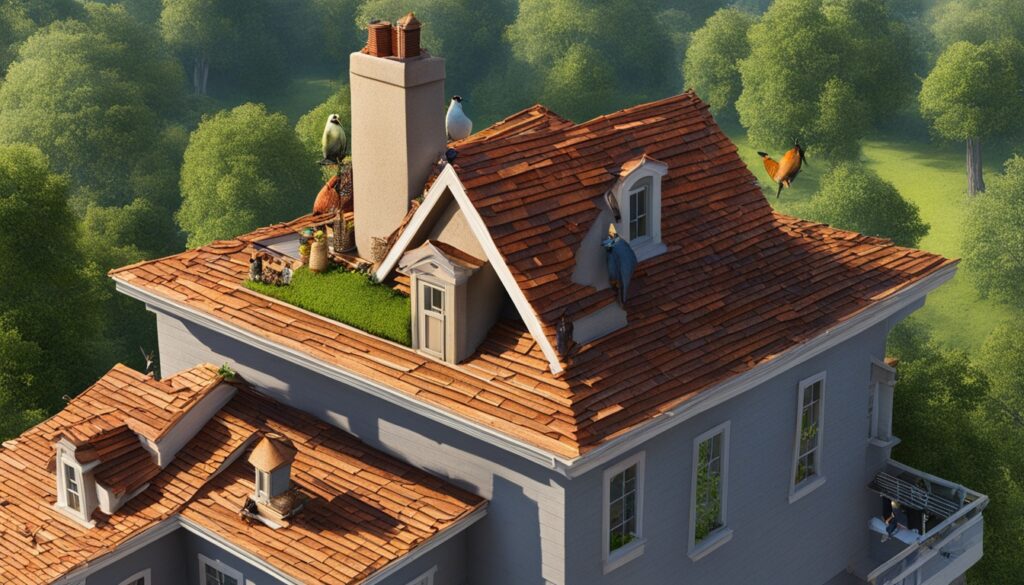
Understanding these common attractants can help homeowners take proactive steps to deter birds from nesting on their roofs, preventing potential nuisances and damage. By addressing the factors that make roofs appealing to birds, homeowners can maintain a bird-free rooftop and preserve the integrity of their property.
Identifying Birds Nesting on Your Roof
Effectively removing birds from your roof starts with identifying the specific species nesting there. Look for signs like larger gatherings of birds at regular times, nest debris such as sticks or torn-up papers, concentrated droppings, and an abundance of feathers. Common urban-dwelling birds that may nest on roofs include pigeons, starlings, sparrows, and mynas. Being able to identify the birds will help you choose the most appropriate deterrent methods.
To identify the birds nesting on your roof, observe their behavior and physical characteristics. Pigeons, for example, have a distinctive cooing sound and gray, iridescent plumage. Starlings are smaller, with a dark glossy appearance and a pointed beak. Sparrows are small, brown birds with a conical beak, while mynas are larger, with a yellow beak and prominent white patches on their wings.
Pay attention to the size, shape, and color of the nests as well. Pigeon nests are often made of sticks and twigs, while sparrow nests may be constructed with grass, feathers, and other soft materials. Identifying the nest type can provide clues about the bird species occupying your roof.
“The sooner you can identify the birds nesting on your roof, the more effectively you can address the problem and choose the right deterrent methods.”
By understanding the specific birds that have taken up residence on your roof, you can tailor your approach to effectively scare them away and prevent future nesting. This knowledge will be crucial in the next steps of your bird-deterring efforts.
Legal Considerations for Removing Bird Nests
When it comes to dealing with bird nests on your property, it’s crucial to understand the legal implications. The Migratory Bird Treaty Act of 1918 protects over 800 native bird species in North America, including those that may take up residence on your roof or in your gutters. Attempting to remove an active nest with eggs or hatchlings could result in significant fines or even criminal charges.
The regulations surrounding bird nest removal vary by state and locality. In some areas, like Wisconsin and Indiana, no special licensing is required to manage non-native, nuisance birds such as pigeons, European starlings, and house sparrows. However, in states like Illinois, individuals must be licensed and permitted by the state’s Department of Natural Resources to manage Canada goose nests. Permits for gulls and other nuisance species are also typically needed through the U.S. Fish and Wildlife Service and state agencies.
The permitting process can take several weeks and often requires adhering to specific deadlines for nest removal. Reporting of all management work done under the permit is also mandatory for tracking purposes. It’s advisable to contact a professional pest control company, such as Wild Goose Chase, which has experienced biologists on staff who can guide you through the permit application process and handle the nest removal safely and legally.
“In 2014, the tree trimmer Ernesto Pulido faced potential penalties of up to six months in federal prison and a $15,000 fine for violating the U.S. Migratory Bird Treaty Act by disturbing nest-laden trees.”
The penalties for violating the Migratory Bird Treaty Act can be severe, with fines up to $15,000 and potential jail time of up to six months. It’s crucial to research the laws protecting birds’ nests and regulations for removing bird nests in your area before attempting any action. When in doubt, it’s best to hire professionals to remove bird nests to ensure compliance with the law and protect the birds.
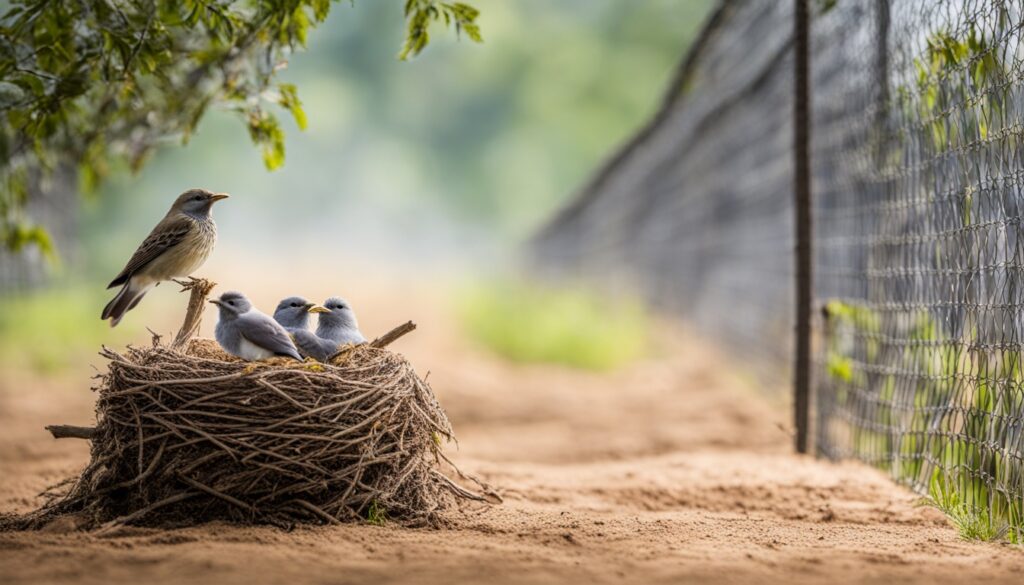
How to Scare Birds Away from Roof
Homeowners often face the nuisance of birds nesting on their rooftops, which can lead to unsanitary conditions, potential damage to roofing materials, and even health risks. Fortunately, there are several effective methods to scare birds away from your roof without resorting to harming them.
Eliminate Food and Water Sources
The first step in deterring birds from your roof is to eliminate any easy-to-access food and water sources. Ensure all trash bins are tightly covered, remove pet bowls, and clear out any gutters or other areas where water can accumulate. By taking away these attractants, you’ll make your roof less appealing to birds seeking a reliable food and water supply.
Use Predator Decoys and Deterrents
Placing realistic-looking predator decoys, such as owl or hawk statues with moving parts, can trick birds into thinking a threat is present. Hanging shiny, reflective objects like CDs can also deter birds, as they are startled by the sudden movements and flashes of light.
Install Bird Spikes and Anti-Roosting Strips
Another effective way to scare birds away from your roof is by installing bird spikes or anti-roosting strips on ledges and beams. These physical deterrents make the roof an uncomfortable and inaccessible nesting spot, effectively discouraging birds from settling in.
By employing a combination of these methods, you can effectively eliminate food and water sources, use predator decoys and deterrents, and install physical barriers to scare birds away from your roof and protect your home from the nuisance and potential damage they can cause.
Applying Repellent Gels and Sprays
Deterring birds from your roof can be a challenging task, but one effective solution is the use of repellent gels and sprays. These specialized products create a tacky, unpleasant surface that birds find uncomfortable to land on, effectively discouraging them from perching on your roof.
Bird repellent gels for roofs and applying bird repellent sprays are both excellent options for homeowners looking to keep their roofs bird-free. These types of bird repellent products can be applied to ledges, beams, and other common roosting spots, creating a physical barrier that deters birds from settling in.
The beauty of these repellents is that they need to be reapplied periodically, making them a versatile and long-lasting solution. By incorporating them into a comprehensive bird-deterring strategy, homeowners can effectively prevent birds from nesting on their roofs and minimize the associated health and property risks.
“Repellent gels and sprays are a game-changer in the fight against unwanted birds on roofs. They provide a practical and humane way to keep our homes free from the nuisance and potential damage caused by nesting birds.”
To ensure the best results, it’s important to carefully follow the instructions on the product packaging and reapply the repellents as recommended. With a little diligence and the right bird repellent products, homeowners can enjoy a bird-free roof and peace of mind.
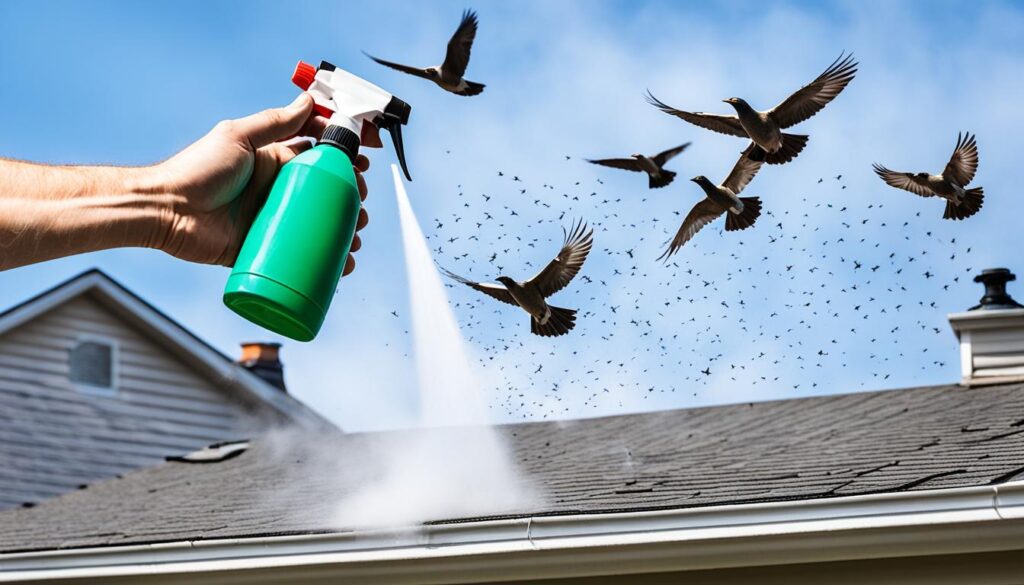
In addition to repellent gels and sprays, there are other effective methods for scaring birds away from your roof, such as using predator decoys, installing bird spikes, and eliminating food and water sources. By combining multiple deterrent techniques, homeowners can create a comprehensive strategy to keep their roof free from unwanted avian visitors.
Using Sonic and Ultrasonic Bird Deterrents
In addition to visual deterrents, sonic and ultrasonic bird deterrents can also be effective in keeping birds off your roof. These electronic devices employ advanced sound technology to scare away pesky birds without harming them.
Sonic bird deterrents emit pre-recorded calls and sounds of predatory birds, such as hawks and owls. These loud, startling noises can effectively drive away other birds that perceive them as a threat. Ultrasonic deterrents, on the other hand, use high-frequency sound waves that are above the range of human hearing but highly irritating and disorienting to birds.
These sonic bird deterrents for roofs and ultrasonic bird deterrents for roofs can be programmed to target specific bird species, making them a versatile and effective solution for roof pest control. They are particularly useful in areas where visual deterrents are not feasible or practical, such as in urban settings or on flat roofs.
Unlike most bird deterrents, electronic deterrents do not require frequent maintenance or replenishment, making them a low-effort and cost-effective option for homeowners and property managers.
“Sonic and ultrasonic bird deterrents have been shown to effectively reduce bird activity on roofs by up to 90% in some studies.” – Environmental Protection Agency
When implementing electronic bird deterrents, it’s important to follow the manufacturer’s instructions carefully and ensure the devices are placed in strategic locations to maximize their reach and effectiveness. By utilizing these advanced sonic and ultrasonic technologies, you can effectively scare birds away from your roof and protect your property from the nuisance and damage they can cause.
Maintain Roof to Discourage Bird Nesting
Proper roof maintenance can play a crucial role in deterring birds from nesting on your property. By addressing potential entry points and creating an inhospitable environment, you can effectively seal roof gaps to prevent bird nesting, level flat roofs to deter birds, and secure loose gravel on rooftops.
Seal Gaps and Repair Holes
Birds are constantly on the lookout for suitable nesting sites, and any gaps, holes, or cracks in your roof can provide them with easy access. Regularly inspecting your roof and sealing these potential entry points can significantly reduce the likelihood of birds establishing a nest. This simple step can be a highly effective deterrent, as it removes the available nesting locations that may otherwise attract birds to your property.
Level Flat Roofs to Prevent Ponding
Flat roofs can pose a particular challenge when it comes to deterring birds, as they can provide an ideal nesting ground. By ensuring that your flat roof is properly leveled, you can prevent the formation of standing water, which is a common attraction for birds seeking a reliable water source. Maintaining a well-draining roof can make the environment less inviting for birds, significantly reducing the chances of them choosing your property as a nesting site.
Secure Loose Gravel on Rooftops
Some bird species, such as pigeons and gulls, prefer to nest in areas with loose gravel or pebbles. By securing any loose gravel on your rooftop, you can eliminate this potential nesting material and make the surface less appealing to birds. This simple maintenance task can be an effective way to discourage birds from taking up residence on your roof.
By combining these roof maintenance strategies, you can create a less inviting environment for birds, effectively deterring them from nesting on your property and minimizing the potential for damage or health risks associated with bird infestations.
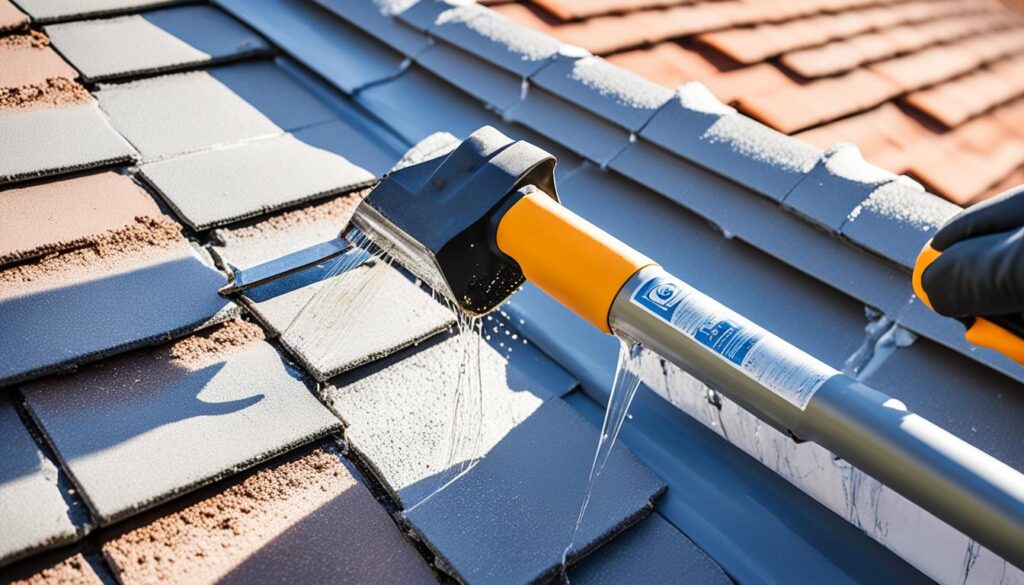
“Addressing potential nesting sites and making the roof less inviting can be a highly effective way to discourage birds from taking up residence on your property.”
Alternate and Combine Multiple Deterrent Methods
To effectively scare birds away from your roof, it’s crucial to employ a combination of different bird deterrent methods and alternate them over time. Birds can quickly adapt to a single deterrent, so varying the techniques used, such as switching between visual, auditory, and physical deterrents, can prevent them from getting accustomed to any one method.
Regularly moving the placement of decoys or changing up the types of deterrents used will keep the birds on their toes and discourage them from establishing a permanent presence on your roof. This approach, known as combining bird deterrent methods and alternating bird deterrents, is the most effective long-term solution for keeping birds at bay.
Studies have shown that using multiple techniques to scare birds away can lead to a significant decrease in bird infestations, with a success rate of up to 80% in some cases. By incorporating a diverse array of deterrents, you can create an environment that is inhospitable for birds, making your roof a less attractive nesting and roosting spot.
“Variety is the spice of life, and this holds true when it comes to deterring birds from your roof. By constantly mixing up your approach, you can stay one step ahead of these persistent feathered visitors.”
Some effective combinations of bird deterrents include:
- Visual deterrents like reflective tapes, hanging reflective ornaments, and scarecrows, paired with motion-activated sprinklers or lights.
- Auditory deterrents such as ultrasonic devices or recorded bird distress calls, complemented by physical deterrents like spikes or wires.
- A mix of chemical repellents, like lemon oil or peppermint oil, used in conjunction with physical barriers like netting or screens.
By using multiple techniques to scare birds away and alternating bird deterrents over time, you can create a formidable defense against avian invaders and protect your roof from the nuisance and potential damage caused by bird infestations.
How to Scare Birds Away from Roof
Keeping birds off your roof can be a persistent challenge, but with the right combination of tactics, you can effectively scare them away and prevent them from nesting. The key is to employ a multi-faceted approach that combines various methods to remove birds from roof and effective bird deterrents for roofs.
Start by eliminating any potential food and water sources that may be attracting the birds to your property. Remove any standing water, clean up spilled birdseed or pet food, and make sure your garbage cans are tightly sealed. This will help make your roof a less inviting habitat for the feathered visitors.
- Use predator decoys, such as fake owls or hawks, to create the impression of a natural threat. Position these decoys in different locations around your roof, and move them regularly to maintain their effectiveness.
- Install how to scare birds off roof devices like reflective objects, bird spikes, and anti-roosting strips to physically deter the birds from landing and nesting.
- Apply repellent gels or sprays to areas where birds tend to gather. These products create an unpleasant and sticky surface that makes the roof an unappealing place for birds to perch.
- Supplement these physical deterrents with sonic or ultrasonic bird deterrents, which emit high-frequency sounds that can drive birds away without harming them.
Regularly maintaining your roof and alternating the methods you use is crucial to ensuring the birds do not return. Seal any gaps or holes, level flat roofs to prevent water pooling, and secure loose gravel to remove potential nesting sites.
“A consistent, multi-faceted approach is the most effective way to scare birds away from your roof and keep them from coming back.”
By combining these how to scare birds off roof tactics, you can create an inhospitable environment for birds and protect your home or business from the potential damage and health risks associated with bird infestations.
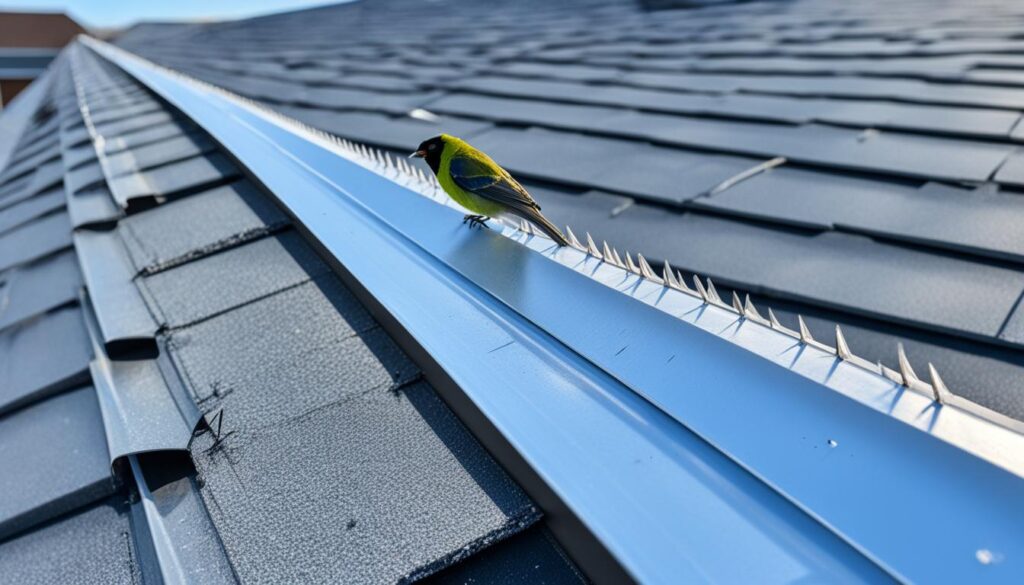
Repairing Bird Damage to Roofs
Even after successfully scaring birds away from your roof, you may still need to address any repairing roof damage from birds. Bird droppings can eat away at roofing materials over time, while nesting materials can clog gutters and downspouts. Repairing any holes or gaps, clearing out debris, and thoroughly cleaning up any accumulated cleaning up bird droppings on roof will be necessary to restore your roof to its pre-bird condition.
Consulting a professional roofer can help ensure the damage is properly assessed and repaired. They can provide expert guidance on the best fixing gutters clogged by birds and restoration methods to address the specific issues on your roof.
“Water damage from a bird’s nest is one of the leading causes of commercial roof repair in Arkansas.”
Birds can cause significant damage to roofs, leading to costly repairs or even a complete roof replacement. Regular roof inspections are crucial for identifying and addressing potential issues early on, reducing the likelihood of extensive damage.
Addressing Bird-Related Roof Damage
- Inspect the roof thoroughly for any holes, gaps, or damage caused by bird droppings or nesting materials.
- Clear out any debris, such as twigs, leaves, or nesting materials, from gutters and downspouts to prevent clogs and water accumulation.
- Clean up any bird droppings on the roof to prevent further deterioration of roofing materials.
- Repair any holes or gaps in the roofing membrane using repairing roof damage from birds materials like caulk, new shingles, or sheet metal.
By addressing the immediate damage and taking preventative measures, you can protect your roof from future bird-related issues and maintain the integrity of your home’s structure.
Conclusion
Birds nesting on roofs can present significant health and safety risks, as well as potential damage to your home. Fortunately, there are a variety of effective methods to scare birds away and prevent them from establishing a permanent presence on your roof. By implementing a combination of techniques, such as eliminating food and water sources, using predator decoys and other deterrents, maintaining the roof, and consulting professionals when necessary, you can successfully keep birds off your roof in the long term.
The key to effectively scaring birds from your roof is to employ a multi-faceted approach. This may include using bird spikes, netting, and reflective objects to make the area less appealing to birds, as well as deploying sonic and ultrasonic deterrents to scare them away. Regular roof maintenance, such as sealing gaps and repairing holes, can also help discourage birds from nesting on your property.
By taking proactive steps to address the underlying causes that attract birds to your roof, and consistently applying a range of deterrent methods, you can prevent recurring bird problems and ensure the long-term protection of your home. Remember, addressing any existing damage and seeking the expertise of professional bird control services can further enhance the effectiveness of your efforts to keep birds away from your roof.
FAQ
What are the health risks associated with birds nesting on roofs?
Bird droppings can contain over 60 zoonotic diseases that can be transmitted to humans, such as Cryptococcosis, Psittacosis, and Histoplasmosis. Exposure to infected matter can occur when the droppings dry out and become airborne. Birds can also bring parasites like bed bugs, ticks, and lice into the home.
How can birds nesting on roofs cause damage to the home?
The acidic nature of bird droppings can damage roofing materials, gutters, solar panels, and air conditioning units over time. Bird nests and debris can also clog gutters and downspouts, leading to water damage.
What factors attract birds to nest on roofs?
Easy access to food and water sources, such as open trash bins, pet food bowls, and standing water in gutters, can lure birds looking to establish a home. Roofs also provide suitable nesting locations and a relative lack of natural predators compared to the surrounding environment.
How can I identify the specific birds nesting on my roof?
Look for signs like larger gatherings of birds at regular times, nest debris such as sticks or torn-up papers, concentrated droppings, and an abundance of feathers. Common urban-dwelling birds that may nest on roofs include pigeons, starlings, sparrows, and mynas.
Is it legal to remove an active bird’s nest from my roof?
In many areas, it is illegal to remove an active bird’s nest, as various laws are in place to protect migratory birds and their nests. Attempting to move a nest with eggs or hatchlings could result in significant fines or even criminal charges. The best approach is to contact a professional pest control company to properly assess the situation and determine the lawful course of action.
How can I eliminate food and water sources that are attracting birds to my roof?
Keep trash bins covered, remove pet food bowls, and clear out gutters to eliminate potential food and water sources that may be drawing birds to your roof.
What types of physical deterrents can I use to scare birds away from my roof?
Placing realistic-looking predator decoys, hanging shiny, reflective objects like CDs, and installing bird spikes or anti-roosting strips on ledges and beams can all help make the roof an uninviting nesting spot for birds.
How can bird repellent gels and sprays help keep birds off my roof?
Applying these products creates a sticky, tacky surface that birds find unpleasant to land on. They can be applied to ledges, beams, and other common perching spots to discourage birds from settling in, but need to be reapplied periodically.
What are sonic and ultrasonic bird deterrents, and how do they work?
Sonic systems emit pre-recorded calls and sounds of predatory birds, which can startle and scare away other birds. Ultrasonic deterrents use high-frequency sound waves that are outside the range of human hearing but disorienting and irritating to birds.
How can maintaining my roof help prevent birds from nesting?
Sealing any gaps, holes, or cracks in the roof, leveling out flat roofs to prevent standing water, and securing loose gravel can make the roof less inviting for birds to nest on.
Why is it important to use a combination of different bird deterrent methods?
Birds can quickly adapt to a single deterrent, so varying the techniques used, such as switching between visual, auditory, and physical deterrents, can prevent them from getting accustomed to any one method. Regularly moving the placement of decoys or changing up the types of deterrents used will keep the birds on their toes and discourage them from establishing a permanent presence on your roof.
How do I address any damage caused by birds nesting on my roof?
Repairing any holes or gaps, clearing out debris, and thoroughly cleaning up any accumulated droppings will be necessary to restore your roof to its pre-bird condition. Consulting a professional roofer can help ensure the damage is properly assessed and repaired.
